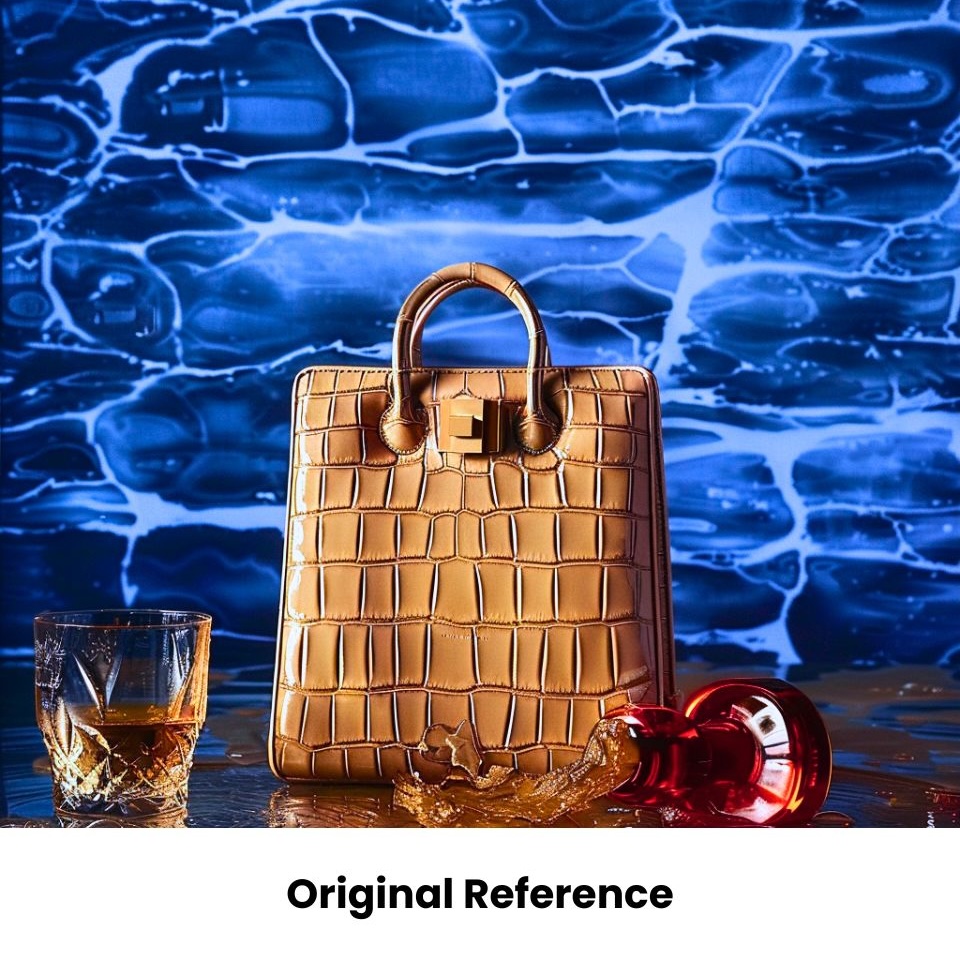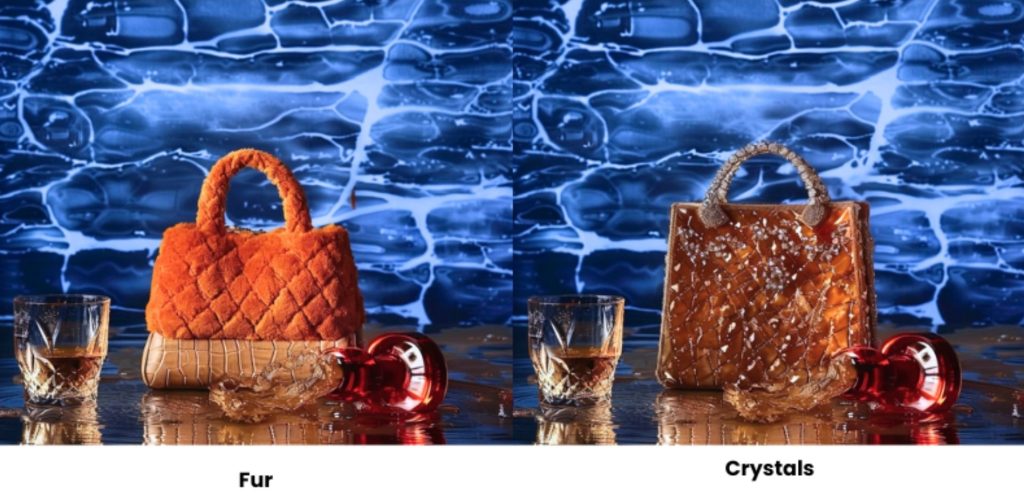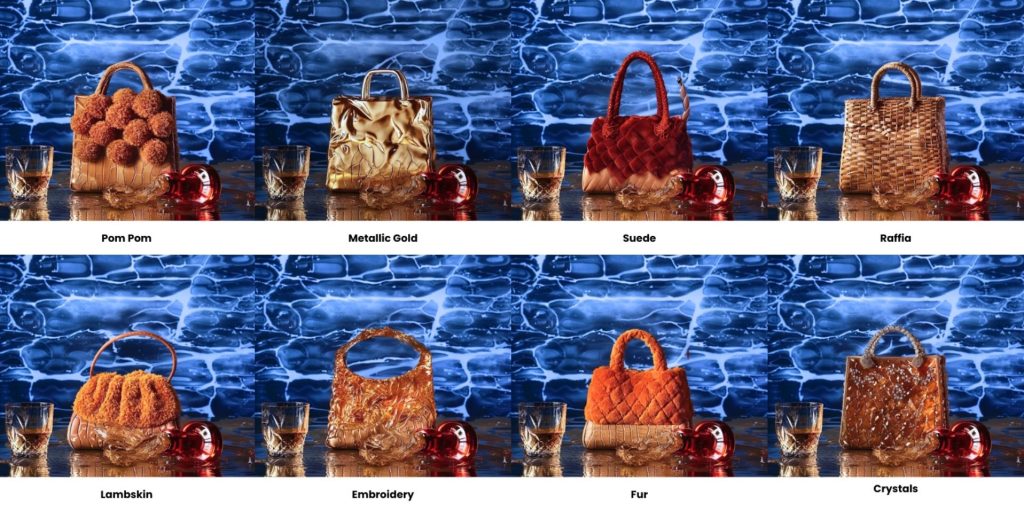At Lude Creative, we’re always exploring new ways to push the boundaries of fashion through AI, and Midjourney’s new #Retexture feature has presented a fantastic opportunity to do just that.
Our team recently ran a test using this innovative tool, applying it to one of our best-selling styles as a base.
The goal?
To envision how we can introduce fresh textures, shapes, and materials based on anticipated future fashion trends and emerging consumer desires.
Here’s an inside look at how we conducted our experiment and the exciting results we uncovered.


1. The Power of #Retexture: Transforming a Best-Seller
For this experiment, we started with a familiar piece—a best-selling design that already resonates with our audience. We chose it because of its existing popularity, which allowed us to see how adding new textures and materials might push it even further. Starting with an image of this style as the foundation, we aimed to see how we could elevate the piece by introducing unconventional materials and unique designs that represent the future of fashion.
Midjourney’s #Retexture feature allows users to blend visual elements and styles in previously unimaginable ways. By combining AI-driven transformations with our creative vision, we experimented with a wide variety of materials and textures. The goal was to see not only how the design itself could be reimagined but also how it could inspire new trends in material use for upcoming collections.
2. Introducing New Shapes, Textures, and Materials
In our experiment, we re-imagined the piece using materials that align with future fashion trends: brown suede, pom-poms, lambskin, embroidery, and crystals. Each material was chosen based on our ongoing research into emerging textures and consumer preferences. Here’s a closer look at each material and how it transformed the design:
Brown Suede: Known for its durability and versatility, brown suede added an earthy, grounded feel to the design. It transformed the look with a soft texture that feels both rustic and modern, ideal for consumers seeking comfort without compromising style.
Pom-Pom Accents: The addition of pom-poms added a playful, avant-garde edge. This whimsical detail brought movement and depth to the design, making it visually striking and unique—perfect for fashion-forward individuals who embrace fun, expressive fashion.
Lambskin: Adding lambskin introduced a sense of luxury and timeless elegance. The smooth, supple texture elevated the piece, aligning it with the luxurious yet understated appeal that high-fashion consumers crave.
Intricate Embroidery: Embroidery has been making a comeback, and we wanted to experiment with how intricate patterns could work on a familiar silhouette. The embroidered details added an artisanal touch, combining craftsmanship with the high-tech precision of AI.
Crystals for a Luxe Finish: Lastly, we incorporated crystal embellishments, capturing the spirit of high-end fashion with a bit of glamour and sparkle. The crystals provided a futuristic, almost ethereal finish, adding a luminous quality to the piece that spoke to consumers looking for a statement piece.

3. A Glimpse into the Future of Fashion
The results were stunning, showing us just how transformative Midjourney’s #Retexture feature can be. Each retextured version provided new inspiration, revealing how unexpected combinations of materials could breathe new life into an existing design. With the #Retexture feature, we saw how we could evolve our best-sellers into pieces that feel entirely new, fresh, and relevant to future trends.
By leveraging AI tools like Midjourney, we’re able to experiment more freely and quickly with concepts that would traditionally require extensive prototyping and testing. This not only reduces production time and costs but also provides us with a limitless playground to envision what fashion could look like in the years to come.

4. Key Takeaways and Implications for the Industry
Our experiment with Midjourney’s #Retexture feature highlighted a few important insights:
Enhanced Creative Flexibility: With AI-driven retexturing, we’re able to play with materials, colors, and textures in ways that aren’t possible through traditional design processes. This is a major advantage for creative teams looking to stay ahead of trends and deliver fresh, engaging designs.
Sustainable Exploration: Experimenting in the digital space means we can explore new styles without the waste associated with physical sampling. By using AI to test materials and design combinations, we’re able to take steps toward a more sustainable design process.
Consumer-Driven Trends: As AI becomes more integrated into our workflows, we’re seeing how digital retexturing allows us to better respond to what consumers want. By tapping into AI’s predictive potential, we’re able to innovate faster and create products that resonate with modern consumers.

Our journey with Midjourney’s #Retexture feature has opened our eyes to exciting new possibilities. We’re looking forward to integrating this tool into our regular design process, allowing us to continuously evolve our collections with new textures, materials, and visual elements that stay ahead of the trends.
At Lude Creative, we believe that AI is not just a tool but a creative collaborator. This experiment has reinforced our vision for a future where fashion design is more agile, consumer-responsive, and ecologically mindful. With Midjourney and other generative AI tools at our side, we’re excited to see where this path takes us—and our audience—next.

